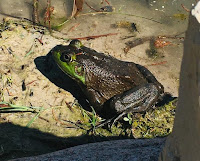Spring Lake Coyote Sightings
Every winter, residents report seeing coyotes in the neighborhood. This year is no exception. A pair of them have been frequent visitors at different times of the day. Here, you see a photo captured by the Gormans through their windows overlooking the lake. Unbelievably close!Coyotes are drawn to urban and suburban neighborhoods for two reasons: human encroachment into native habitat and the availability of food. For this reason, it's smart to secure garbage cans and keep them in your garage. If you compost, use enclosed bins and avoid adding dog or cat waste, meat, milk or eggs to the bin. This will only attract them.
These coyotes are active and healthy, and we see them foraging and tracking for food--a reminder that we need to protect our pets. Coyotes are not fussy eaters, so a cat or dog can become a quick lunch. They have been known to take down deer and can scale a 6-foot fence. So please keep your companion animals indoors and accompany them when outdoors. If you happen to meet up with a coyote while walking your dog, pick up your dog if it is small...and keep it close to you if your dog is medium-sized or large.
Here's a quick video that demonstrates how to "haze" coyotes if/when they approach you. Hazing by all members of a neighborhood will discourage them from building a den nearby and encourage them to find other territory for their activities.





















